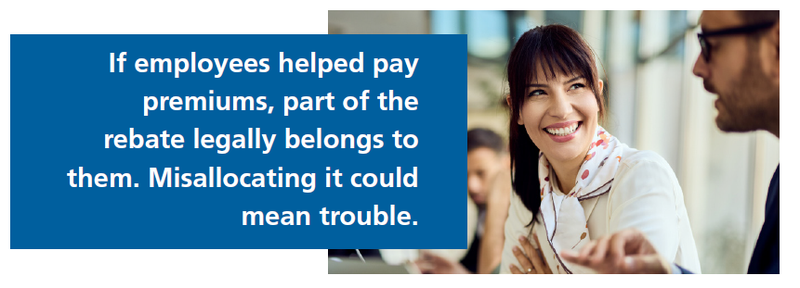MLR Rebates: What They Are, Why They Matter, and What Employers Must Do
April 23, 2025

An MLR rebate check lands on your client’s desk. It seems straightforward at first glance, but there’s more beneath the surface. Deadlines, tax considerations, and ERISA rules all come into play. One wrong move can create a compliance issue that spirals fast. This is a critical moment to offer clear guidance and help your client avoid headaches they didn’t see coming.
Even though the rebate process is relatively simple on paper, questions often arise about who is entitled to the money and how it should be used. Employers rely on their brokers for answers, and clients turn to the brokers who bring clarity again and again.
Remember, rebates may arrive once a year, but the right guidance leaves a lasting impression.

What Are MLR Rebates?
Under the Affordable Care Act (ACA), health insurance carriers must spend a minimum percentage of premium revenue on actual healthcare services and quality improvements rather than administrative costs or profits. This requirement is known as the Medical Loss Ratio (MLR), and the thresholds are:
If a carrier does not meet these standards, it must issue rebates to policyholders by September 30 each year. In the group health market, the policyholder is typically the employer.
Importantly, rebates are not based on an individual employer’s claims history. Instead, they reflect the carrier’s performance across the entire market segment. That means an employer with high claims could still receive a rebate if the insurer exceeded its allowable profit margin overall. Conversely, a low-claim employer may receive nothing if the carrier stayed within the MLR target.
Most rebates are modest, often between $100 and $400 per employee, but amounts can vary. Understanding the calculation helps manage client expectations and clarifies why some groups receive checks while others do not. Since rebate amounts fluctuate year to year, they should be viewed as a financial bonus, not a dependable part of the budget.
Who Gets the Rebate, and How Should It Be Used?
While rebates are issued to the policyholder (usually the employer), that does not mean they can simply keep the full amount. If employees contributed to the cost of premiums, a portion of the rebate is considered a plan asset and must be used for their benefit.
For instance, if premium costs were split 70/30 between employer and employees, at least 30% of the rebate must go back to the employees in some form. Failing to allocate rebates properly could lead to ERISA violations, Department of Labor audits, or other compliance consequences.

Helping clients determine how much of the rebate is attributable to employee contributions and how to return it appropriately can protect them from missteps and build confidence in your guidance.
Key Compliance Considerations
To avoid compliance pitfalls, employers must handle MLR rebates with care. Keep clients ahead of the curve by walking them through key areas such as:
A Broker’s Perspective
MLR rebates are one of those quiet but critical moments to help prove your value. These conversations go far beyond compliance and into the realm of strategy and relationship-building.
Clients may initially view MLR rebates as just a year-end bonus. But once they understand the compliance layers involved, many are eager to learn more about how to manage long-term costs. This also opens the door to broader financial strategies.
Rebate season becomes the perfect time to revisit other cost-containment options, such as:
These discussions help highlight your expertise in healthcare finance and position you as a year-round partner, not just an enrollment season contact.

What’s on the Horizon?
Regulatory scrutiny around MLR rebates is growing. The Department of Labor and the IRS have signaled increased oversight, especially in how rebates are calculated and allocated.
At the same time, industry groups are pushing for updates to the rebate structure. Some advocate for more flexibility in how rebates can be used, while others are calling for a formula that better reflects employer contributions. If adopted, these proposals could significantly reshape rebate processes in the years ahead.
Being aware of these discussions and ready to respond helps you stay ahead of client questions. When new rules are finalized, employers will be looking for someone they trust to walk them through the changes.
Bottom Line
MLR rebates may seem routine, but they can have real impact when handled with insight and care. This is a chance to guide clients through complex decisions, prevent compliance issues before they start, and reinforce the value of your expertise in a meaningful way.
BenefitMall is here to back you up with compliance guidance, expert resources, and the tools you need to support your clients with confidence. Whether you need help answering a tough question, clarifying ERISA rules, or identifying new ways to control costs, your local team is ready to help.
Stay ahead of the next question, the next regulation, and the next opportunity. Connect with BenefitMall today, and let’s work together to keep your clients informed and your business moving forward.
Contributor: Misty Baker is the Director of Compliance and Government Affairs at BenefitMall